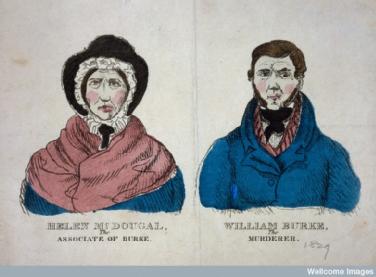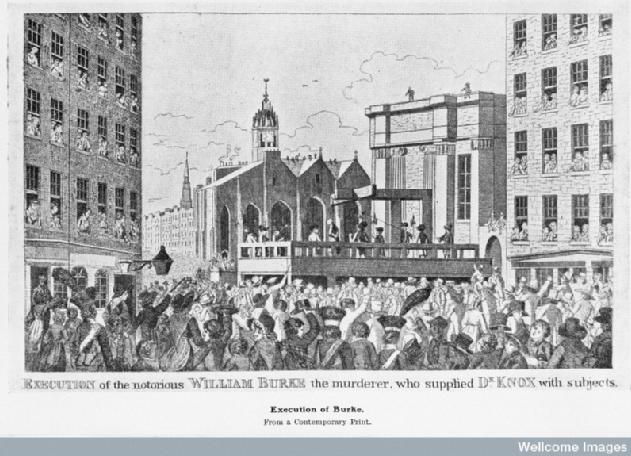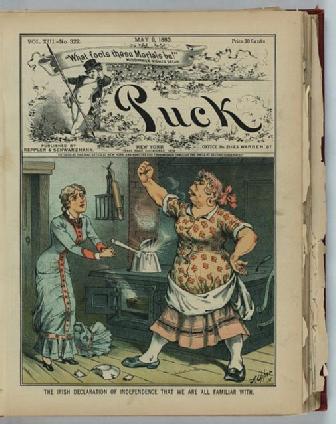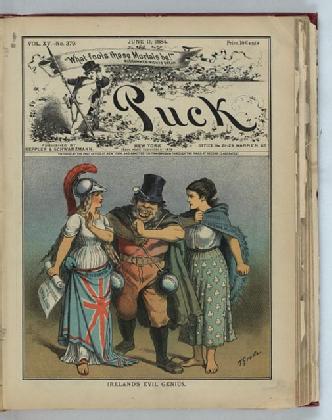"The ready-made nucleus of degradation and disorder"?: Crime and the Irish in the Nineteenth Century
Jennifer Crane

In 1828 the Irish migrants William Burke and William Hare committed a series of murders in Edinburgh, in order to sell the corpses to the surgeon and anatomist, Doctor Robert Knox (1791-1862). The practice of selling corpses to anatomists was described as ‘body snatching’, and Burke and Hare had extended grave robbing to murder to boost their income from this profitable trade. Knox, like many other anatomists of the era, struggled to gain enough corpses for his research and teaching as the supply of bodies for anatomical purposes was limited to individuals condemned to 'death and dissection' by the courts. Burke and Hare killed at least ten people, and three of the identified victims were Irish migrants.
Burke and Hare were caught in November 1828. By testifying against Burke, Hare received immunity from prosecution. Burke, by contrast, was hanged, dissected, and displayed. The murders committed by Burke and Hare became the subject of many ballads, cartoons, and newspaper articles.
Execution of William Burke (1820s), Wellcome Library, London

Beyond this dramatic and horrific case, the nineteenth century also saw a range of criminal acts committed both by and against Irish migrants. At this time Irish migrants were popularly perceived as particularly disposed to violence. Indeed, in 1839 the philosopher Thomas Carlyle proclaimed that 'in his squalor and unreason, in his falsity and drunk violence' the Irishman was 'the ready-made nucleus of degradation and disorder'. Yet, as the historian Roger Swift has emphasised our actual knowledge of Irish criminality is 'limited and patchy in both time and place', because few accurate and detailed sources are available. Swift acknowledged that Irish migrants were well represented in British crime statistics, and almost three times more likely to face prosecution than their English neighbours. Irish criminality was concentrated in less serious categories of crime, primarily drunkenness, disorderly behaviour, assault, petty theft, and vagrancy. Migrants often drank in 'wabble shops', where alcohol was sold illegally, without a license. Swift argued that such crimes were a product of the high rates of poverty amongst Irish migrants, many of whom lived within brutalising urban slum environments.
Catherine Cox, Hilary Marland and Sarah York have analysed the records of several asylums in Lancashire operating in the late nineteenth century, and amongst these located sources relating to Irish migrants and crime. Margaret Murphy, for example, was an Irish migrant who was moved from the Walton Workhouse to an asylum in Lancashire when 'found wandering' in Bootle and apprehended by police. Though aged only 41, Margaret was described in the asylum documents ‘as an old woman’. The documents also stated that Margaret was ‘very violent at times, she will rush upon other patients to injure them’. Another Irish migrant, John Currie, was removed from Kirkdale Prison, where he had been sent for stealing clothing, and placed in Rainhall asylum in November 1874. The case notes wrote that Currie 'was badly bruised on admission, and had been ‘very restless the whole of the time he has been in there [prison] . . .had set fire to his bedding'. Another patient, Dennis McKeon, claimed to have been badly beaten while in prison and was 'one mass of bruises from head to foot' when admitted to Rainhall Asylum in August 1868. Whilst at Rainhall Dennis stole food from other patients and received 'a very awkward scalp wound'. Dennis was briefly released but returned to the asylum after his wife claimed that he had tried to kill her. This snapshot of diverse examples illuminates the various ways in which Lancashire asylums described Irish migrants engaging in a range of criminal behaviours inside and outside of the asylum.
Roger Swift and L.P. Curtis have highlighted the role of anti-Irish prejudice in raising the perception and prosecution of Irish criminality. Many contemporary newspapers presented stereotypes of Irish migrants as drunken, uncivilised, or as carriers of disease. The cartoons below, from Punch magazine, mocked Irish migrants and represented their facial features as entirely different to those of Britons.


Left Hand Image: Frederick Burr Opper, 'The Irish declaration of independence that we are all familiar with', Puck, 13, 322 (1883), < www.loc.gov/pictures/item/2012645471/>. Right Hand Image: Fredrich Graetz, 'Ireland's Evil Genius', Puck, 15, 379 (1884), <www.loc.gov/pictures/item/2012645207/>
In the context of such anti-Irish stereotypes and mythologies, much crime was committed against Irish migrants. Crime against Irish migrants escalated following the rise of Irish Republicanism and the bombing campaigns of the late nineteenth century (see ‘The Irish, Politics and Sectarianism in Nineteenth-Century Lancashire’). Resentment of the Irish community was especially rife amongst the English working classes, many of whom felt that Irish migrants, who were widely accused of undercutting wages, threatened their employment prospects. In 1892 the Dublin weekly newspaper The Nation bemoaned that 'nowhere in England can our countrymen consider themselves safe from English mob violence'. People with Irish names and accents were often physically attacked, banned from applying for jobs, and excluded from public houses and shops.
Thus, Irish migrants were not a 'ready-made nucleus of degradation and disorder', but had a complex relationship with criminality in the nineteenth century. Irish migrants were often thought of as criminal, and this group was overrepresented in petty crime statistics, but, at the same time, Irish migrants were often themselves the victims of crime, and faced prejudice, discrimination, and poverty.
Further reading:
Catherine Cox, Hilary Marland and Sarah York, 'Emaciated, Exhausted, and Excited: The Bodies and Minds of the Irish in Late Nineteenth-Century Lancashire Asylums, Journal of Social History 46:2 (2012), 500-24.
Roger Swift, 'Heroes or Villains?: The Irish, Crime, and Disorder in Victorian England', Albion: A Quarterly Journey Concerned with British Studies, 29:3 (1997), 399-421.
Roger Swift, 'The Outcast Irish in the British Victorian City: Problems and Perspectives', Irish Historical Studies, 25: 99 (1987), 264-76.
For a cinematic comedy about the Burke and Hare murders, see Burke and Hare (2010), a film starring Bill Bailey and Simon Pegg.
